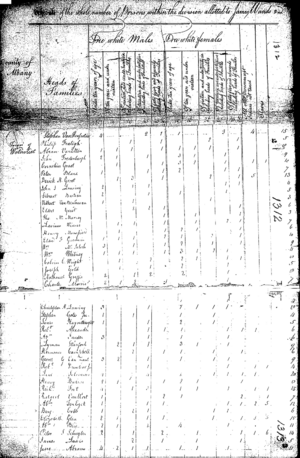1810 United States census facts for kids
Quick facts for kids 1810 United States census |
|
|---|---|

Seal of the United States Marshals Service, which administered the census
|
|

A page of the 1810 United States census
|
|
| General information | |
| Country | United States |
| Date taken | August 6, 1810 |
| Total population | 7,239,881 |
| Percent change | |
| Most populous state | Virginia 983,152 |
| Least populous state | Delaware 72,674 |
The 1810 United States census was the third census conducted in the United States. It was conducted on August 6, 1810. It showed that 7,239,881 people were living in the United States, of whom 1,191,362 were slaves.
The 1810 census included one new state: Ohio. The original census returns for the District of Columbia, Georgia, Mississippi, New Jersey, and Ohio were lost or destroyed over the years. Most of Tennessee's original forms were also lost, other than Grainger and Rutherford counties.
This was the first census in which New York was ranked as the most populous state, if excluding West Virginia from Virginia. Otherwise this would be the last census with Virginia ranked as the most populous state.
Contents
Census questions
The 1810 census form contained the following information (identical to the 1800 census):
- City or township
- Name of the head of family
- Number of free white males under age 10
- Number of free white males age 10 to under 16
- Number of free white males age 16 to under 26
- Number of free white males age 26 to under 45
- Number of free white males age 45 and over
- Number of free white females under age 10
- Number of free white females age 10 to under 16
- Number of free white females age 16 to under 26
- Number of free white females age 26 to under 45
- Number of free white females age 45 and over
- Number of all other free persons
- Number of slaves
Note to researchers
Census taking was not yet an exact science. Before 1830, enumerators lacked pre-printed forms, and some drew up their own, resulting in pages without headings. Some enumerators did not tally their results. As a result, census records for many towns before 1830 are idiosyncratic. This is not to suggest that they are less reliable than subsequent censuses, but that they may require more work on the part of the researcher.
Data availability
No microdata from the 1810 population census are available, but aggregate data for small areas, together with compatible cartographic boundary files, can be downloaded from the National Historical Geographic Information System.
State rankings
| Rank | State | Population |
|---|---|---|
| 01 | Virginia | 983,152 |
| 02 | New York | 959,049 |
| 03 | Pennsylvania | 810,091 |
| 04 | Massachusetts | 700,745 |
| 05 | North Carolina | 556,526 |
| 06 | South Carolina | 415,115 |
| 07 | Kentucky | 406,511 |
| 08 | Maryland | 380,546 |
| 09 | Connecticut | 262,042 |
| 10 | Tennessee | 261,727 |
| 11 | Georgia | 251,407 |
| 12 | New Jersey | 245,555 |
| 13 | Ohio | 230,760 |
| — | Maine | 228,705 |
| 14 | Vermont | 217,713 |
| 15 | New Hampshire | 214,360 |
| – | West Virginia | 105,469 |
| 16 | Rhode Island | 76,931 |
| — | Louisiana | 76,556 |
| 17 | Delaware | 72,674 |
| — | Mississippi | 31,306 |
| — | Indiana | 24,520 |
| — | Missouri | 19,783 |
| — | District of Columbia | 15,471 |
| — | Illinois | 12,282 |
| — | Alabama | 9,046 |
| — | Michigan | 4,762 |
| — | Arkansas | 1,062 |
City rankings
See also
 In Spanish: Censo de los Estados Unidos de 1810 para niños
In Spanish: Censo de los Estados Unidos de 1810 para niños

